One of the most overlooked aspects of the AR-15 rifle is the gas block.
The gas block is responsible for how much gas escapes the barrel each time the weapon is fired, which directly impacts the gun’s recoil, accuracy, and reliability.
In this article, we will cover what gas blocks are in greater detail and how to select one.
Basics of Gas Blocks

The gas block is simply a piece that fits over a hole on the top of the barrel of an AR-15 rifle or carbine.
How it works is when the weapon is fired and gunpowder present in the cartridge explodes, the bullet is driven through the barrel and past the hole.
Some of the hot gas will escape the hole, enter the gas block, and then be directed down the gas tube.
The gas tube will then direct the hot gas back towards you, the shooter, and down the receiver.
This results in the bolt being pushed backward, which in turn causes the cartridge to be extracted before a new round is loaded from the magazine into the chamber so the weapon may be fired again.
The gas block is basically a valve that controls how much hot gas will be directed back to the receiver.
This means that regardless of which ammo you are using, you can control how much gas gets sent back to the receiver, even if you are using a heavier or more powerful load.
This enables you to optimize your AR-15 for virtually any set up you desire.
Standard vs. Adjustable Gas Blocks
There are two primary kinds of gas blocks: standard and adjustable.
A standard gas block only allows a fixed amount of gas to travel through the tube, and more often than not, this is more gas than is necessary.
Why would you want this?
The reason is because if the hot gas carries with it a lot of carbon, it can cause the interior of the AR-15 to be clogged up.
By sending more gas down the receiver than is necessary, the system will still run reliably even when it gets rather dirty.
Granted, this will also result in more wear and tear being inflicted on your rifle, but there is a trade off to anything.
Standard gas blocks are also far simpler than adjustable gas blocks, which is exactly why many Ar shooters prefer them.
That being said, an adjustable gas block allows you to more carefully fine tune the amount of gas that enters the receiver of your rifle.
The bolt can then receive the perfect amount of gas, or force, that it needs. You can then decrease how much carbon gets into the system as well, so cleaning your AR-15 will be much less of a hassle.
The biggest draw back to an adjustable gas block is they require more maintenance and time in order to operate for the sole reason that they are adjustable.
The trade off, however, is that they create much less recoil than a standard gas block. They also enable a direct gas impingement AR-15 to run much more smoothly.
Overall, standard gas blocks are often recommended for duty AR-15 rifles to ensure that they run reliably, while adjustable gas blocks are more often used for AR-15 rifles used for competition or target shooting use where precision is highly valued.
Low Profile Gas Blocks
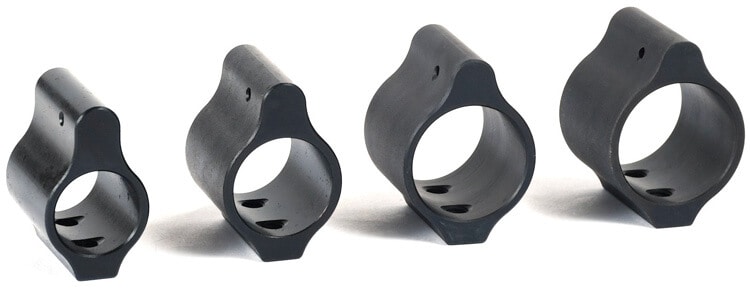
The low profile gas block allow full length hand guards and free floating rail systems to be used on your AR-15 rifle when you install them.
So long as your gas block is adjustable, it will also have what is called a bleed off hole, or a hole that can be used to reduce the gas blowback, especially when you opt to add a suppressor to your rifle.
Picatinny Front Sight Gas Block
The Picactinny front sight gas block features a picatinny rail that will allows you to mount any front sight designed for an AR-15 to the top of the rail.
Usually this picatinny rail will be at a much lower plane than the upper receiver, so it is something that you will want to keep in mind.
This way, if you have an AR-15 rifle that does not already come with a front sight or the option to install it, you can easily install it by adding the gas block.
Gas Blocks Size
Gas blocks come in a variety of different sizes.
.750 is the best size to go for a medium or standard barrel, while .936 is the ideal size for a heavy bull barrel, and .625 is the best size for a pencil barrel.
.875 is also available for customized barrels, but they are also not nearly as common.
For reference, you can follow this guide:
- .750 for Standard Barrel
- .936 for Bull Heavy Barrel
- .625 for Pencil Barrel
Gas Block Materials
Gas blocks are also available with a wide variety of different kinds of materials, including each of the following:
Aluminum
Aluminum is by far the weakest choice for a gas block and so is not highly recommended. Repeated heat cycling can cause the gas block to become loose after repeated use if you go with aluminum.
Carbon Steel
Carbon steel is easily the most popular choice for an AR gas block. Not only is it simple to machine, it is also very durable and has a greatly reduce odds of becoming loose after repeated heat cycling.
That being said, carbon steel is also prone to rust. So it can erode after time.
Stainless Steel
Stainless steel offers far greater rust resistance than carbon steel, and it’s very chemical resistant as well.
It also offers superior durability over carbon steel too. That being said, it’s also more difficult to machine and is much more expensive, so you will pay a premium price for it.
Titanium
Titanium is the most durable option on this list, and it is very chemical and corrosion resistant. It’s also 40% lighter than carbon steel despite it being stronger.
That being said, titanium is also a premium price and is therefore going to cost you the most amount of money.
Mounting Types: Clamp On vs. Set Screw
There are two primary methods for attaching a gas block to an AR-15 barrel: by set screwing it on or clamping it on.
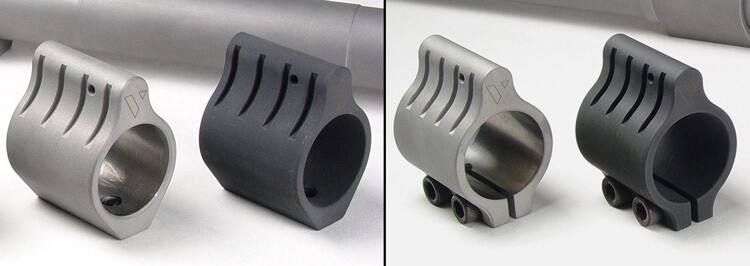
Screwing the gas block on is definitely the most popular choice and it is more stable and reliable. You simply slide the gas block onto the barrel and then anchor it down with set screws through the underside.
With the clamp on gas block, you slide them down the barrel and then tighten the screws. This action is not as strong as the set screw method, so it’s not nearly as recommended.
Top 6 Best AR-15 Gas Block 2024
Here are some examples of the best AR-15 gas blocks on the market today:
1 Superlative Arms Adjustable Gas Blocks
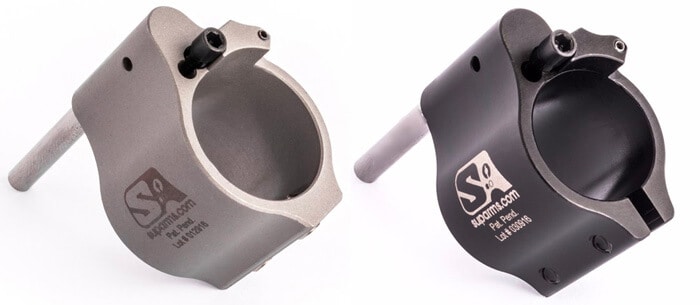
This is a direct impingement gas block that works by adjusting the gas flow bleeding gas out of the gas block instead of restricting flow, which stands in stark contrast to more traditional gas blocks, and that furthermore will not result in erosion or carbon build up.
It is also removable with a safety mechanism that will prevent you from withdrawing the screw all the way out. As a result, you will feel greatly reduced recoil from your AR-15 with this superlative arms adjustable gas block.
The pressure in this gas block will be reduced to the absolute minimum, allowing it to run cooler.
This block also has thirty separate locked positions, with a length of one inch and a melonite finish for greatly improved rust resistance. The gas block itself is built out of a highly durable stainless steel.
2 JP Enterprises Adjustable Gas Block
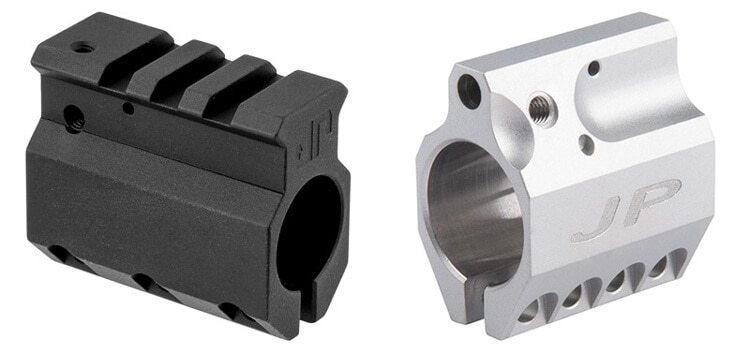
The JP Enterprises Adjustable Gas Block allows you to tune your AR-15 gas system for superior operation and cycling.
In particular, this gas block is a good choice for varmint and match rifles when you shoot custom and factory ammunition.
It is a set screw gas block that allows you to more efficiently control the flow of gas so you can more effectively customize the setting that you need for each of your loads.
The set screws are hex head and installation instructions are included so that you can easily add them.
3 Odin Works Low Profile Adjustable Gas Block
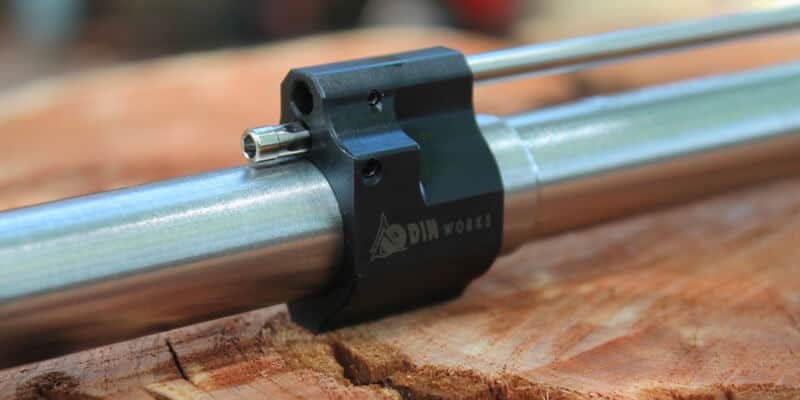
The Odin Works Low Profile Gas Block is one of the most adjustable gas blocks on the market, with over twenty clicks of ball detent adjustment available.
It is built out of steel and has been black nitrided for superior rust resistance and durability.
The front facing adjustments screw and spring has been designed to handle very high temperatures.
This block will also fit any AR-15 barrel with a .750 diameter regardless of the caliber of the rifle.
4 Seekins Precision .750 Adjustable Low Profile Gas Block
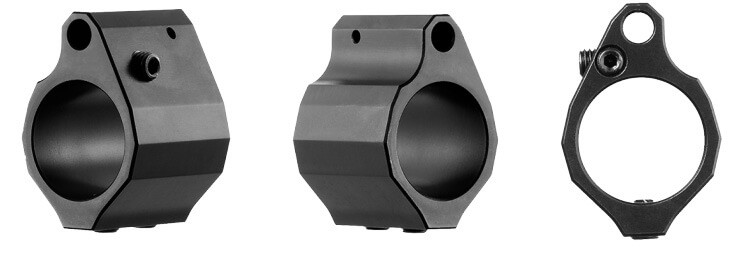
The Seekins Precision .750 Adjustable Low Profile Gas Block allows you to easily adjust the amount of gas flow, which in turn means that you can tune the gas output for very reliable ejection and extraction regardless of the type of ammo you are using.
It also comes with a brass friction screw to hold the adjustment easily without the thread locker and so the adjustment screw won’t be marred.
Dual bottom screws are located on the bottom to block the barrel, and they require Allen wrenches in order to use.
5 Geiselle Super Low Profile Gas Block

If you are looking for a gas block that will work well with a free float rail for your AR-15, then you’ll need to pay close attention to the Geiselle Super Gas Block.
This is an all-steel construction gas block that is designed to provide more than enough strength for your block so it can easily resist erosion from hot gas created from the rifle.
Meanwhile, it has also been machined very precisely in order to fit over most .750 barrels. This gas block also ships with instructions and mounting hardware as well.
6 SLR Rifleworks Titanium Adjustable Gas Block
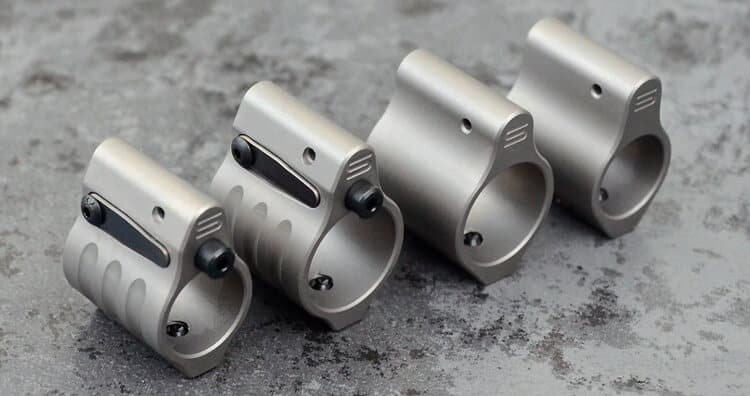
The SLR Rifleworks Titanium Adjustable Gas Block will help ensure that you can easily adjust your AR-15’s flow of gas in contrast to a more traditional gas system that is far more limited.
This gas block is built out o a very durable and yet lightweight titanium with a bead blasted finish to help resist wear and corrosion. It features two set screws that are located .40 inches apart from one another.
It also comes with a tool you can easily use to adjust the gas meter one click at a time and without having to use a spring loaded system that can be more easily damaged.
How To Install A Pinned Gas Block
Here are the steps that you will need to follow for installing a pinned gas block:
- Use an Allen wrench to loosen both set screws
- Use an armorer’s hammer to tap on the gas block near the muzzle
- The gas block should no dislodge
- Slide off the gas block carefully
- Install the barrel nut once the gas block is off; follow the manufacturer’s instructions on this step
- Slip the gas block over the muzzle and onto your gas block
- Center the gas block with the upper receiver of the AR-15
- Tighten both of the set screws from the underside with your hammer
- Take the roll pin and line it up with the hole through the bottom of the gas block
- Hold the roll pin and your size 4 starter punch, and tap until the pin is centered in the gas block
- The process is now complete
Conclusion
Now that you know what AR-15 gas blocks are and what to look for in one, you can more easily choose the best gas block that you will need for your AR-15 rifle.

